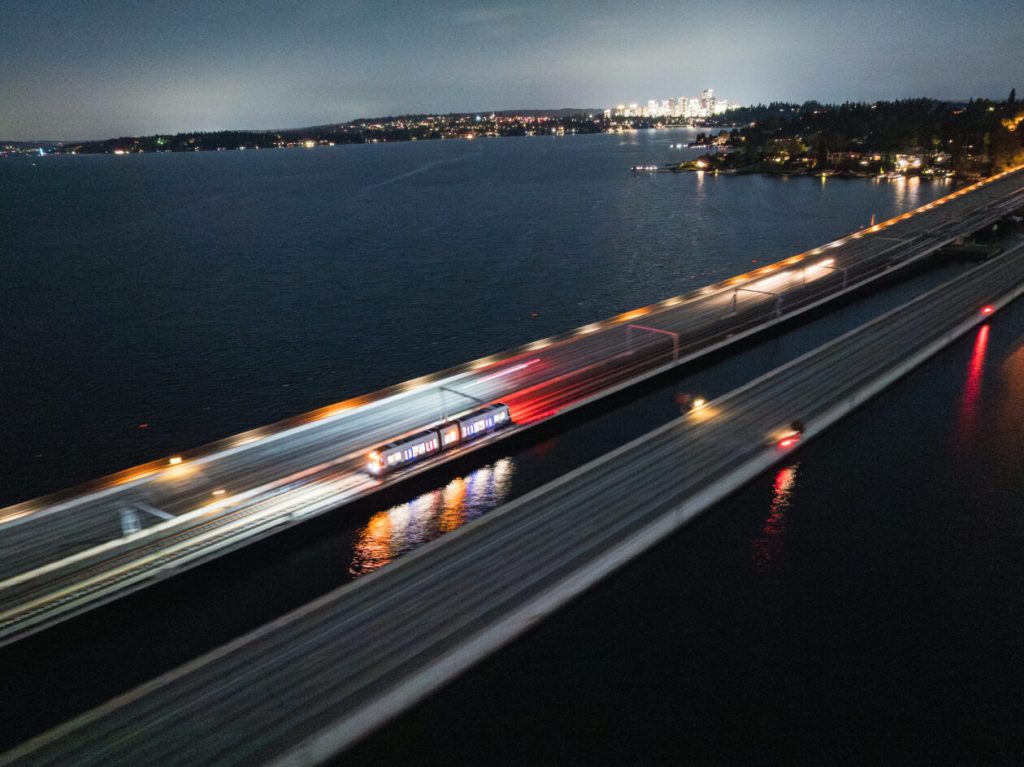Seattle’s Revolutionary Transit Achievement: Light Rail Crosses Floating Bridge
Seattle marked a groundbreaking achievement in transportation engineering this week as a Link light rail vehicle successfully traversed the I-90 floating bridge under its own power. This historic milestone, announced by Sound Transit, represents the first instance worldwide of a train operating across a floating bridge. The “Crosslake Connection” test showcases the innovative spirit that Seattle is known for and signals a significant shift in commuting possibilities between the region’s major tech centers on opposite sides of Lake Washington.
During Monday night’s testing phase, a single train made multiple crossings of the bridge at progressively increasing speeds, starting at approximately 5 mph and eventually reaching the full operational velocity of 55 mph. Sound Transit conducted these tests overnight to allow engineers to carefully observe and document the expected electrical arcing occurring between the overhead power wires and the light rail vehicle. The successful test run revealed stunning visuals—a train gliding across Lake Washington with the illuminated Bellevue skyline as a backdrop, presenting a glimpse into the future of regional transportation. Testing will continue intermittently between the new stations at Mercer Island and Judkins Park as preparations advance for the grand opening of the complete Link light rail 2 Line scheduled for early 2026.
When fully operational, the 2 Line will establish a vital connection between downtown Seattle, downtown Bellevue, and the Redmond Technology station located at Microsoft’s headquarters campus. This new transportation option stands to dramatically transform the daily commutes of thousands of tech workers and other professionals who currently navigate the often congested routes across Lake Washington between their homes and workplaces at major companies like Microsoft, Amazon, Google, and Meta. The roughly 13-mile journey between Seattle and Microsoft’s headquarters—a trip that can unpredictably take anywhere from 20 minutes to two hours depending on traffic conditions—has long been a source of frustration as the region’s tech boom and subsequent population growth have overwhelmed existing roadway infrastructure.
The significance of this transit expansion extends beyond mere convenience. Bellevue has experienced remarkable growth in recent years, particularly with Amazon’s expanding presence. The tech giant has previously announced plans to establish approximately 25,000 corporate employees across various buildings in Bellevue, complementing the roughly 50,000 workers already based in Seattle. “Our downtown Bellevue campus was designed around the connectivity that mass transit provides, both for the community and the businesses that are growing here,” noted David Zapolsky, Amazon’s senior vice president of global public policy and general counsel, when the 6.6-mile East Link segment of the 2 Line, including eight stations, opened earlier this year in April. That segment alone is already serving over 10,000 daily passengers, according to reports from The Seattle Times, demonstrating the immediate demand for improved transit options in the region.
The engineering challenges involved in running rail tracks across a floating bridge cannot be overstated. This ambitious project has navigated numerous obstacles since its inception in 2016, including complicated ballot measures, budget overruns, and technical delays that pushed the opening date from its original 2023 projection to 2026. The floating bridge solution required innovative approaches to accommodate the movement of the bridge with changing water levels and weather conditions, while maintaining the stability and safety required for rail operations. The complex technical solutions developed for this project could potentially serve as a model for similar transit challenges worldwide, further cementing Seattle’s reputation as a center for transportation innovation.
Sound Transit’s achievement represents more than just a transportation advancement; it symbolizes the region’s commitment to sustainable growth and forward-thinking urban planning. As Seattle and its surrounding communities continue to evolve as global tech hubs, the need for efficient, environmentally conscious transportation solutions becomes increasingly critical. The Crosslake Connection addresses this need directly by providing an alternative to the carbon-intensive commutes that currently dominate the region. For tech workers who have endured years of unpredictable commute times and traffic congestion, the light rail expansion offers not just a more reliable journey but potentially transformative improvements in quality of life—reclaiming hours previously lost to traffic and reducing the stress associated with daily commutes.
The successful test run across Lake Washington marks just the beginning of what promises to be a revolutionary chapter in Seattle’s transportation story. As testing continues and the 2026 opening approaches, the region stands on the cusp of a significant shift in how people move between its major economic centers. The images captured during Monday’s test—a sleek train gliding across the water against the nighttime skyline—offer a compelling vision of the future: one where innovation meets necessity, where engineering overcomes natural obstacles, and where a region’s growth is supported by infrastructure that connects rather than divides. For Seattle’s tech community and the broader population alike, the light rail’s journey across Lake Washington represents not just a crossing of physical distance but a bridge to a more connected, sustainable future.


